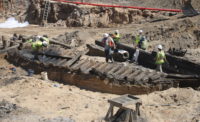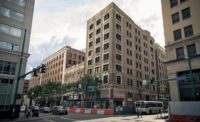Founded on the banks of the Potomac River in 1749, Alexandria, Va., served as one of the busiest seaports in early U.S. history. So it wasn’t surprising that the team building a three-acre, mixed-use project on the waterfront in Alexandria’s Old Town area discovered a wealth of colonial artifacts during excavation. Still, archaeologists from the project team and the city didn’t expect to discover the remains of three mid-18th-century wooden ships at the $185-million Robinson Landing project site.
To help unearth the abandoned sailing ships—commonly used to shore up areas for docks in the 1700s—the team brought in a specialized vertical cutter post mounted on a base crawler machine, a machine that project officials say is not typically deployed in the MidAtlantic region. Using modern methods, the machine built a trench cutting and remixing deep (TRD) soil mix wall, a 21st-century shoring method, according to the project team.
“Every area of the site contained significant archaeological features,” says Greg Griffin, senior director of EYA Multifamily Construction LLC. EYA oversees construction management on the project through its affiliates collectively known as the Robinson Landing Development Entities while also serving as developer in the joint venture with JBG Fund IX LLC and Mitsui Fudosan America.
The team kept the venture on schedule during the more than 23-month archaeological investigation. The project site covered a full city block, which was large enough to allow construction in areas unaffected by the finds, according to Griffin. The team also maintained the schedule despite a tight urban site that was subject to excessive groundwater and flooding and also adjacent to sensitive historic buildings.
Located in what was most recently an industrial site, the project will include 70 condos, 26 townhouses, retail space and a restaurant when it is completed in the summer of 2020. A renovated 300-ft-long and 40-ft-wide pier with floating docks—along with areas for public seating and an outdoor lounge—will serve as the southern anchor to Old Town.
Minimizing Vibration
Onsite activities began soon after the site was acquired in the summer of 2016, with demolition followed by site preparation. Known for its historic colonial buildings, some of them along cobblestone streets, Old Town required the team “to modify our demolition procedures to minimize vibration to adjacent structures,” Griffin says.
Existing masonry and steel buildings, including a warehouse, were removed with standard demolition procedures. The buildings sat on a 10-in. to 12-in.-thick reinforced concrete pad that spanned more than two acres with areas of deeper footings. “The original demolish plan for the slab was to use a hoe ram to punch through the slab in a grid pattern to allow it to be broken apart,” Griffin says.
Instead, larger demolition equipment was used “that allowed the slab to be lifted and broken apart without the vibration associated with the hoe ram procedure,” he says.
To further reduce the impact on Old Town Alexandria streets and adjacent property, the company used barges on the Potomac River to remove 20,000 tons of excavation materials and bring infill material to the site.
The Big Dig
Because the city of Alexandria has long experience with historic finds in construction sites along the Potomac, city staff archaeologists joined members of WSSI Thunderbird Archeology, a division of Wetland Studies and Solutions Inc., in April 2017 to begin the dig.
The hull fragment of the largest ship—which is roughly 85 ft long and 30 ft wide at its widest point, according to reports from the city archaeologists—was discovered in March 2018 while clearing the site for construction of an underground garage.
The two other ships each measured about 50 ft in length and 15 ft in width.
The team needed to re-bury the remains of one of the ships to allow construction to proceed, Griffin says. “Then once the permanent slurry wall was installed, the feature was re-excavated within the footprint of the garage and disassembled and removed for future restoration. This effort occurred while construction continued.”
Time was also saved by beginning the archaeological investigation while waiting for the approvals from the Federal Emergency Management Agency needed for construction, Griffin says.
The archaeological dig was completed in November 2018, and EYA donated artifacts and more than a thousand pieces of timber to the city for preservation.
Staying Dry
With the high-water table next to the river, keeping the site dry during the entire archeological investigation and construction proved challenging, says Neal Frumkin, project executive for the main general contractor, Donohoe Construction, Bethesda, Md. Soils across the site consisted of interbedded layers of silty sand and gravels, soft lean clay and stiff fat clay.
The third ship’s hull lay partially within the project site footprint at 25 ft below working grade; it was buried so deep it was undermining a city wall, according to Frumkin.
The team solved that problem by constructing a watertight TRD earth-retention system. Geotechnical engineering specialist Hayward Baker Inc., which was already on site when the ships were discovered, brought in the machine, which Frumkin likens to “a giant chain saw.”
The TRD is a purpose-built trenching machine, says Joseph A. Mann, project executive manager at Hayward Baker, which is based in Hanover, Md. “It is a form of soil mixing that cuts a continuous trench from wall top to bottom with no joints or overlaps.” The machine advances horizontally along the wall alignment while the cutter post cuts and mixes soil with cement-based binder slurry. The full-depth vertical cutter post vertically blends the soil, eliminating any stratification and creating a nearly homogenous soil mix wall, Mann says.
The project involved excavating two levels of below-grade parking. A “bathtub” cut-off structure was needed to make sure there was no impact to surrounding properties through dewatering-induced settlement or migration of contaminated groundwater. Hayward Baker installed an internally braced, vertical soil-cement TRD perimeter cut-off extending to a depth of approximately 80 ft and keyed into the underlying marine clay. The TRD wall was designed to function as both a permanent cut-off and temporary earth retention solution.
Mann says the team had to make “a number of changes on the fly to accommodate deeper excavation” to remove the third merchant ship. That ship was discovered while the team prepared excavation for an already designed wall alignment “in the exact area we intended to start production,” Mann says. So the excavation had to proceed more than 6 ft deeper than the intended 18 ft to remove the ship. That required 41-ft-long steel soldier beams instead of 32-ft ones and a supplemental internal bracing system to enable the deeper excavation. He says all changes were made while the project was being mobilized “to yield zero impact to the project schedule.”
Griffin calls using that process for installing the deep foundation component “innovative for this marketplace.”
He says that the project was able to use the TRD soil mix wall to avoid water infiltrating the building footprint, allowing the team to combine the support of excavation [SOE] system—a temporary earth retaining system to control the ground and provide space for construction—with the permanent water mitigation design.
The SOE system eliminated the time and expense of installing driven piles and significantly reduced the size and complexity of the permanent dewatering system.
The archaeological work cost three times the original projections for that part of the project. “Although significant, it only represented a portion of the overall development costs,” Griffin says.
Project officials say they “adjusted” the budget to accommodate the lengthy archaeological dig. They declined to specify how large the adjustment was.








